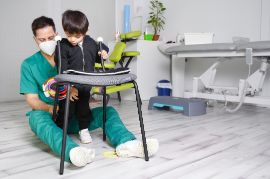From sports injuries to congenital deformities, children can have issues that result in dysfunctional movement or pain with activity.
 While your pediatrician may help diagnose the problem and tell you why it’s happening, a Physical Therapist is often your best bet for treatment. Their extensive training in how bodies move, altered movement patterns, and reasons behind both, helps them restore functional movement in patients.
While your pediatrician may help diagnose the problem and tell you why it’s happening, a Physical Therapist is often your best bet for treatment. Their extensive training in how bodies move, altered movement patterns, and reasons behind both, helps them restore functional movement in patients.
They are also well-versed in movement accessories, such as orthotics, braces, and shoe wear. From sports injuries to congenital deformities, children can have issues that result in dysfunctional movement or pain with activity.
Injuries
Children get hurt. That’s just what they do. If they didn’t fall off the slide at the playground, how would they learn to slow down the next time? These types of bumps and bruises (and sometimes breaks) of the bones are called orthopedic injuries. Physical Therapists can help your child get back to running around quicker by stretching, strengthening, and improving coordination of the injured area.
As opposed to older methodology of casting and bedrest for months, Physical Therapists advocate for the child to be more active in their recovery to improve long-term outcomes. Take, for instance, an ankle sprain. If your child rolls his/her ankle while playing basketball, it may help to simply ice, rest, and wear a brace. However, later in life, he/she may have issues controlling their ankle if the surrounding muscles are still weak or poorly coordinated, putting him at increased risk of reinjury. Physical Therapy can help reduce that risk.
Conditions That Benefit from Physical Therapy
One common orthopedic condition among children that is not acquired through injury, but is congenital, is scoliosis. Otherwise known as a curvature of the back, scoliosis has long been tested for in schools and is considered a condition where either bracing or surgery is necessary. However, research demonstrates that using scoliosis-specific exercises via Physical Therapy, if done early enough, can reduce the need for brace prescription and surgical intervention. Since research on this topic is fairly new, some physicians have not begun prescribing Physical Therapy for scoliosis first, but it never hurts to ask.
Another common condition treated by Physical Therapists among pediatric patients is a postural deformity called torticollis. This occurs in babies shortly after birth and is denoted by a side-bending of the head in one direction and rotation of the head in the opposite direction Many new parents are frightened when they hear something may be wrong with their newborn. Typically, however, it is an easily treatable condition. Your Physical Therapist will help by stretching the baby’s neck, doing gentle soft tissue massage, and teaching you how to do the stretches and activities at home with your baby.
Physical Therapists also treat several neurological and genetic conditions in children, which may be congenital or acquired during the birthing process. These include cerebral palsy, autism, Down Syndrome, general developmental delay, traumatic brain injuries, and spinal cord injuries. Whether the child is fully participatory or wheelchair enabled, a Physical Therapist is their advocate to get them moving their best, maintain their abilities, and plan for future needs.
Physical Therapists use their skills to help children of all abilities feel and move better. Their unique sets of skills allow them to be hands-on, fun, and innovative, all while keeping your child safe and happy. One thing to remember is that children are not small adults, and while most Physical Therapists have entry-level training in pediatrics, there are many who focus exclusively in pediatrics that may serve children under 12 more effectively.
Call Iron City Physical Therapy today to speak to a Physical Therapist about how your child might benefit from Physical Therapy.
References
1. Zapata KA, Sucato DJ, Jo CH. Physical Therapy Scoliosis-Specific Exercises May Reduce Curve Progression in Mild Adolescent Idiopathic Scoliosis Curves. Pediatr Phys Ther. 2019;31(3):280-285. doi:10.1097/PEP.0000000000000621.
2. Kaplan SL, Coulter C, Sargent B. Physical Therapy Management of Congenital Muscular Torticollis: A 2018 Evidence-Based Clinical Practice Guideline From the APTA Academy of Pediatric Physical Therapy. Pediatr Phys Ther. 2018;30(4):240-290. doi:10.1097/PEP.0000000000000544




